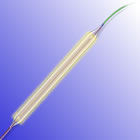|
Medtronic IN.PACT drug-eluting balloons received CE (Conformité Européenne) mark in 2008 and 2009 and are available in many countries around the world. They are not commercially available in the United States. BELLO With both devices eluting paclitaxel, the late lumen loss (LLL) rate associated with the IN.PACT Falcon drug-eluting balloon (0.09 mm ± 0.38 mm) was superior to the Taxus DES (0.30 mm ± 0.44 mm) on the primary endpoint of in-stent/in-balloon LLL at six months (p=0.001).
"The results of the BELLO study show that Medtronic's IN.PACT Falcon drug-eluting balloon may be a viable alternative to drug-eluting stents in treating small coronary vessels that have narrowed due to atherosclerosis, in addition to vessels with in-stent restenosis," explained Dr. Antonio Colombo of Ospedale San Raffaele in Milan, co-principal investigator and presenter of the BELLO study. "Encouragingly, the angiographic findings of the independent core lab are concordant with the clinical results." In addition, rates of major adverse cardiac events (MACE) between the two groups were similar at six months:
Importantly for assessing the results, nearly two-thirds (64.9%) of the vessels treated in the BELLO study with Medtronic's IN.PACT Falcon DEB were smaller than 2.25 mm in diameter, for which no DES is currently available. PACIFIER On the primary endpoint results of LLL at six months, there was a statistically significant difference (p = 0.0014) and exceedingly low rate (-0.01mm) of LLL associated with the use of Medtronic's IN.PACT Pacific drug-eluting balloon compared to patients treated with an uncoated balloon (0.65mm). PACIFIER also significantly favored the IN.PACT Pacific drug-eluting balloon on a composite of death, amputation, and the need for target lesion revascularization (TLR) at one year (7.1% versus 34.9%, p=0.002). "While preliminary drug-eluting balloon data from uncontrolled trials have been promising, the interventional community has eagerly awaited the results from a randomized trial to validate the clinical benefit of Medtronic's IN.PACT drug-eluting balloons," commented Michael Werk, M.D., assistant medical director for the Department of Radiology at the Martin Luther Hospital in Berlin and PI and presenter of the PACIFIER trial. "Earlier research has hypothesized that drug-eluting balloons can reduce late lumen loss, restenosis rates and the need for repeat target lesion revascularization, and now the one-year results of PACIFIER show, in a randomized forum, to what extent these results are possible." Ultimately, Medtronic's global IN.PACT clinical program will include 24 studies involving approximately 4,000 patients and 200 sites across more than 80 countries worldwide. Through these company-sponsored and physician-initiated studies, Medtronic IN.PACT drug-eluting balloons will be investigated thoroughly for the treatment of arterial disease in coronary and peripheral vessel beds. Last month, for example, Medtronic announced the start of the IN.PACT Global SFA clinical study, an international research program to evaluate the treatment of peripheral artery disease using the company's IN.PACT Admiral™ drug-eluting balloon in up to 1,500 "real world" patients. The first patient in the study is expected to be enrolled by the end of May. In collaboration with leading clinicians, researchers and scientists, Medtronic offers the broadest range of innovative medical technology for the interventional and surgical treatment of cardiovascular disease and cardiac arrhythmias. The company strives to offer products and services that deliver clinical and economic value to healthcare consumers and providers worldwide. About Medtronic Any forward-looking statements are subject to risks and uncertainties such as those described in Medtronic's periodic reports on file with the Securities and Exchange Commission. Actual results may differ materially from anticipated results. Source: Medtronic, Inc. |


